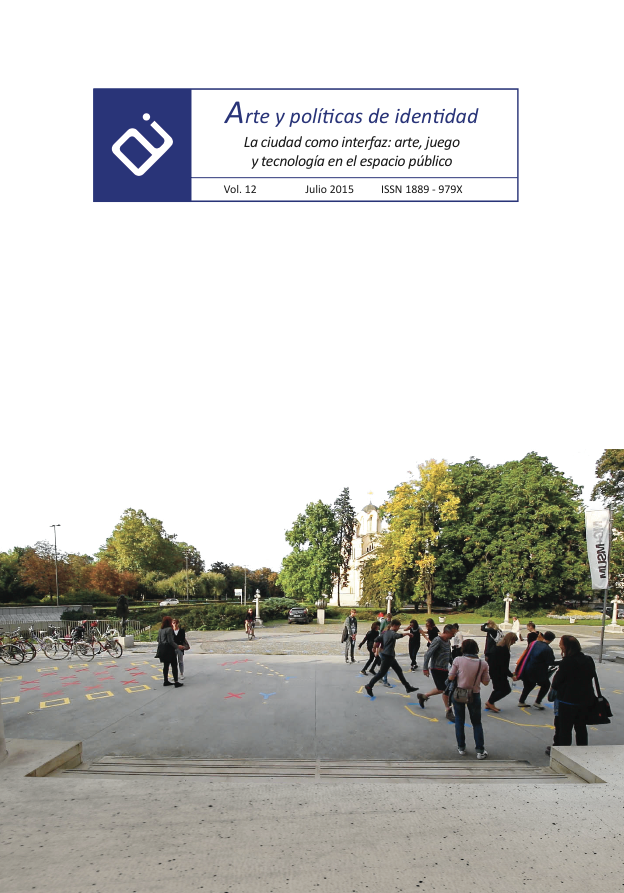Revitalizing Public Space from Communication and Creative Neomedial Practice: New Languages for Dialogue Between the Citizen and the Urban Environment
Abstract
The modern city is built, developed and practiced from communication, and language, key in the formation of thought, culture and identities, evolves in society. We should therefore consider the ability of new languages emerging from the integration of new technologies in the urban environment to propose a new type of communication with the city to revitalize its different spaces.This article describes the different types of public spaces from which citizens determine their relationship with the city. Similarly, we study how the creative incorporation of ICTs in the most usual elements of these places helps to perceive them as relationship urban spaces, experienced by the citizens through interaction, identifying clues that help us to better understand communication in the city and its relationship with the emergence of a hybrid city. From the analysis of significant creative contributions of the last decade different languages and types of communication that occur in the city are identified, reflecting on trends and scenarios relevant to the fields of art and design, aimed at strengthening the concept of a practiced city that aims to revitalize the various urban spaces.
Downloads
-
Abstract661
-
PDF (Español (España))414
References
Augé, M. (1996). Los No Lugares: espacios del anonimato. Barcelona: Gedisa.
Ascher, F. (2004). Los nuevos principios del urbanismo: el fin de las ciudades no está a la orden del día. Madrid: Alianza.
Brynskov, M., Dalsgaard, P., Ebsen, T., Fritsch, J., Halskov K., & Nielsen, R. (2009). Staging Urban Interactions with Media Façades. En T. Gross et al. (Ed.), Human-Computer Interaction – INTERACT 2009 Part I (pp.154-167). Berlin: Springer.
Castells, M. (1995). La ciudad informacional: tecnologías de la información, reestructuración económica y el proceso urbano-regional. Madrid: Alianza.
Cerdà, I. (1968) Teoría General de la Urbanización. Madrid: Instituto de Estudios Fiscales.
Choay, F. (1996). La Règle et le Modèle. Sur la theorie de l’architecture et de l’urbanisme. Paris: Seuil.
Cocchia, A. (2014). Smart and Digital City: A Systematic Literature Review , en R. P. Dameri & C. Rosenthal-Sabroux (Eds.), Smart City. How to Create Public and Economic Value with High Technology in Urban Space. New York: Springer International Publishing.
Dalsgaard, P. & Halskov, K. (2010). Designing Urban Media Façades: Cases and Challenges. Proceedings of the SIGCHI Conference on Human Factors in Computing Systems 2010, 2277-2286. Recuperado el 7 de septiembre de 2014, dehttp://dl.acm.org/citation.cfm?id=1753670
Dameri, R. P. & Cocchia, A. (2013). Smart city and digital city: twenty years of terminology evolution. Proceeding of Italian Chapter of the Association for Information Systems ITAIS Conference. Recuperado el 20 de agosto de 2014, de http://www.cersi.it/itais2013/pdf/119.pdf
Deakin, M. (2014). Smart Cities: Big Data, Civic Hackers, and the Quest for a New Utopia. New York: Routledge.
Echeverría, J. (1999). Los señores del aire: telépolis y el tercer entorno. DesBarcelona: Destino.
Fritsch, J. & Dalsgaard, P. (2008). Media Facades BeyondInteraction. Proceedings of the 20th Australasian Computer-Human Interaction Conference OZCHI 2008. Recuperado el 7 de septiembre de 2014, de http://www.peterdalsgaard.com/documents/publications/fritsch%20-%20media%20facades%20beyond%20interaction.pdf
Haeusler, M. H. (2009). Media facades: history, technology, content. Ludwigsburg: AVEdition Press.
López, S. (2003). El túnel de las metáforas. Percepción de la vivienda y del entorno urbano como experiencia artística. Scripta Nova, 7 (146). Recuperado el 27 de diciembre de 2014, de http://www.ub.edu/geocrit/sn/sn-146%28036%29.htm
McLuhan, M. (1962). The Gutenberg Galaxy: The Making of Typographic Man. Toronto: University of Toronto Press.
Mitchell, W. J. (1996). City of Bits: Space, Place, and the Infobahn. Cambridge: MIT Press.
Montejano, J. A. (2013). El impacto de las nuevas tecnologías en la explosión de la ciudad. URBS. Revista de Estudios Urbanos y Ciencias Sociales, 3 (1), 5-67.
Oberti, I. & Pavesi, A. S. (2013). The triumph of the smart city. TECHNE: Jorunal of technology for architecture and enviromnment, 0 (5), 117-122
Pérez, M. A. (2012). Fachadas tecnológicas: de cómo la arquitectura se convierte en un media. En P. Amador et al. (Eds), Imagen, Cultura y Tecnología: medios, usos y redes. Actas del Segundo Congreso Internacional sobre Imagen, Cultura y Tecnología (pp. 59-70). Madrid: Universidad Carlos III.
Pourian, J. (2012). The ‘holy grail’ of hacks. The construction of one of the most anticipated hacks of all time. The Tech Online Edition, 132 (22), 8-9. Recuperado el 27 de diciembre de 2014, de http://tech.mit.edu/V132/PDF/V132-N22.pdf
Realities: United (2005). Sitio Oficial. Recuperado el 12 de septiembre de 2014, dehttp://realities-united.de/#PROJECT,81,1
Schubiger, S. (2008). Large Screen Interaction in Public Space: TowerTalk and NOVA. En R. Adams, S. Gibson y S. Müller Arisona (Eds.), Transdiciplinary Digital Art: Sound, Vision and the New Screen. Berlin: Springer.
Scientific American Editors (2014). Designing the Urban Future: Smart Cities. New York: Scientific American.
Toh, M. H. & Low, L. (1993). The intelligent City: Singapore achieving the next lap: practitioners fórum. Technology Analysis & Strategis Management, 5 (2), 187-202.
Tokmakoff, A. & Billington, J. (1994). Consumer services in Smart city Adelaide. En K. Bjerg y K. Borreby (Eds.), Proceedings of Home-oriented informatics, telematics and automation. HOIT94. Copenhague: University of Copenhagen. Recuperado el 8 de septiembre de 2014, de http://uwforum.org/upload/board/10.1.1.33.9536%5B1%5D.pdf
Works published in this journal are subject to the following terms:
- The Service of Publications from the University of Murcia (publishing house) keeps the published works’ copyrights, and favors and allows the reuse of these works under the license indicated in point 2.
- Works are published in the journal’s online edition under the license Creative Commons Reconocimiento-NoComercial-SinObraDerivada 3.0 España(texto legal). They can be copied, used, disseminated, transmitted and publicly exhibited, as long as: i) the author and original source of publication are cited (journal, publishing house and work’s URL); ii) they are not used for commercial purposes; iii) the existence and specifications of this license are mentioned.
3. Conditions for auto-file. It is allowed and encouraged that authors share electronically their pre-print version (the pre-reviewed version) and /or post-print version (the reviewed and accepted version) of their Works before the publication, since it promotes its circulation and dissemination. RoMEO color: green.










